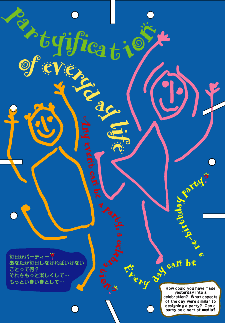

Why "Playful"?
Our theme is designing learning with a "playful" spirit. The exploration mark after the world "playful" accounts for any number of words such as spirit, passion, lifestyle, design, expression - anything you would like to insert!
The word "playful" itself contains many possible interpretations. Each of us can develop our playful spirit through engaging in various activities and by building relationships with other learners and with knowledge itself. We can become designers of our own intelligenceas well as feel an invaluable sense of motivation - what we have termed "playful motivation".
The term "playful" is often limited to children. However, our hope is that the playful spirit will be nurtured in the hearts of all youths and adults, creating pure, intimate and self-empowering relationships with people and objects we meet in everyday life.
Why "Playshop"?
Many changes are occurring in Japanese education - indeed in education all over the world. The concept of "playshop" can help us all rethink our ideas about teaching and learning. Considering key elements such as relationship, motivation, interaction, personal connections, and empowerment of all learners, we believe that the traditional classroom style needs to be redefined. Therefore, we are proposing redesigning our learningscapes.
The playshop metaphor can foster meaningful learning thorugh design activities which emphasize the essence of engagement, emotion, improvisation, innovation, collaboration, communication and reflection. Also it is important to remember that playful design is intergenerational and that it provokes emotional and collaborative experiences. This kind of learning advocates a self-empowering design spirit and a hands-on, hearts-in philosophy such as when making a mudpie. Playful design nurtures spontaneous and emergent creativity. In a playshop environment, learners become the meaning makers rather than simply taking meaning from others. Through the elements of magical and spontaneous engagement and learning how to break constraints in a supportive, playful environment, all of us can develop and utilize our own toys, tools and vision.























